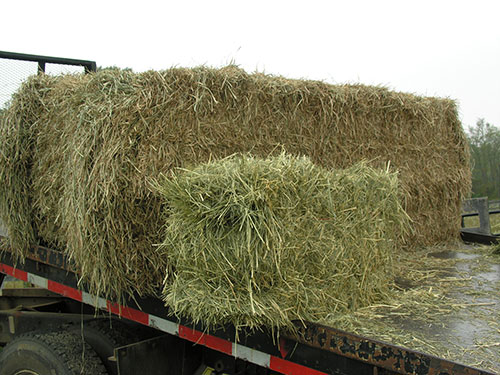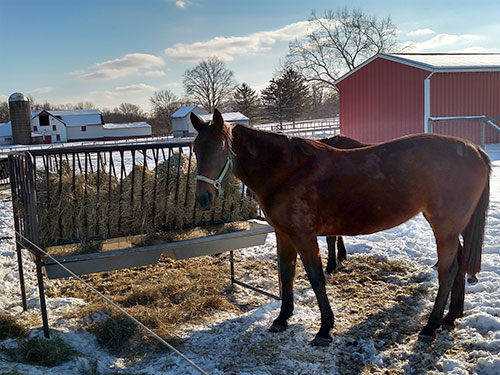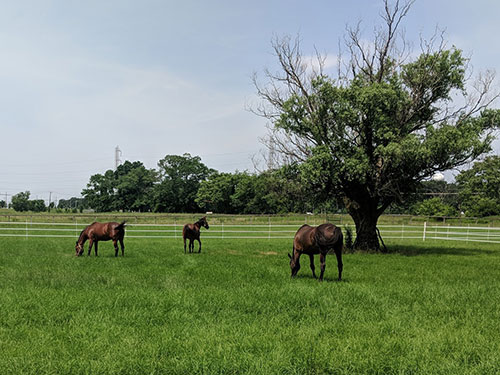
Fact Sheet FS073
Forages such as long-stem hay and/or pasture grasses and legumes are the traditional cornerstones of horse rations. A good source of forage should comprise at least 75% of a horse's daily intake, which would be about 15 lbs. for an average 1,000 lb. horse. While an important source of energy, protein, minerals, and vitamins, forages also provide fiber that horses require to maintain a healthy hindgut. Long-stem hay and pasture grasses contain over 20% crude fiber, whereas most grain mixes will be around 10%, whereas "complete" feeds will be at least 25%. Horses can adapt to balanced rations that do not contain hay or pasture, but the absolute minimum of fiber necessary has not been established. However, low fiber/high concentrate rations have been documented to increase the risk of colic, gastric ulcers, and wood chewing behavior of horses.
Unfortunately, in times of drought, or other adverse weather conditions, the pastures dry up and long-stem hay is not only expensive, but hard to find. But if hay costs soar, what is a horse owner to do?
Luckily, we do have some options. Listed below are some forage substitutes that can be safely incorporated into horse rations to provide the necessary fiber.
"Complete" Concentrates

Figure 1. Dried complete fed can be soaked and turned into a mash for horses with dental problems.
Complete feed concentrates are available in textured, pelleted, or extruded forms, these complete concentrates are mixtures of grains, hay and/or beet pulp, and vitamin and mineral supplements. They are designed to be fed without hay, grain, or other supplements while still meeting the basic needs of the horse. Complete feeds are available in a wide variety of nutritional profiles, so it is important to read the labels to determine which will meet your horse's needs (i.e., adult maintenance versus the young growing or performance horse). These feeds are used a lot with older horses with dental problems because they can be turned into a mash that the horse does not need to chew but slurp up and swallow with little trouble.
The label of these feeds should contain the statement "designed to be fed without forage" or should provide feeding directions if used both with and without forage. Usually, 15 lbs. of a complete feed are needed to meet the average 1,000 lb. horse's daily needs, which, if split into only two feedings, will overwhelm the horse's digestive capacity. Therefore, feeding smaller amounts (3–4 lbs. per feeding) more frequently will optimize digestion and keep the horse more occupied. Complete feeds should be used instead of, not in addition to, a horse's regular grain ration. Horses should be switched to the complete rations slowly, taking over a week to eliminate hay from their diet and to get them on the amounts of complete feed necessary to meet their needs.
Hay Cubes
Hay cubes are basically long-stem hay, either alfalfa or grass hay, like timothy or orchard grass, and sometimes a mixture of the two that is dried, chopped, and compressed into cubes. These are usually sold in 40-50 lb. bags that are easily transported and stored, making them more readily available from regions where the hay crop was good. The wood chewing can be reduced by feeding at least some long-stem hay or straw (see below), and the danger of choking is eliminated by soaking the cubes in water for 10 minutes before feeding them.
Many horses that are not able to consume or digest long-stem hay can have cubes as their sole source of forage. If this is the case, it is best to use straight grass hay or an alfalfa mixed cube. Straight alfalfa cubes will contain more protein and calcium than the normal adult horse needs but will not harm the horse if its kidneys are functioning properly. Alfalfa cubes are more appropriate either for lactating mares or growing horses and as a partial forage substitute. While up to 15 lbs. or more can be fed per day, as little as 2 to 6 lbs. of cubes per day can be used as a "hay extender" if only poor-quality hay is available in limited quantities.

Figure 4. Beardless wheat straw pictured here. Important to not have straw of any kind have the long beards on the grain as they can cause sores in the horse's mouths.
Some cubes are formulated to be a complete diet, they are called a total mixed ration (TMR) cube and are balanced with extra vitamins and minerals and some even with a little added grain or molasses to increase the energy content. If feeding horses these as a sole source of feed, using a TMR cube is the best option.
Straw
The stalks left over from harvesting wheat or other grain crops contain little nutritional value, but straw is a great source of fiber. If the horse's energy, protein, mineral, and vitamin needs can be met by a complete pelleted, extruded, or textured concentrate, then bedding on straw will reduce the amount of wood chewing and satisfy the horse's desire to chew. If horses have not had access to forage and are suddenly placed on straw, however, there is a serious risk of impaction colic. Straw should not be considered as a source of nutrition for horses other than as a "chew factor" and fiber source.

Figure 5. Raw beet pulp looks a bit like ground up shoe leather.
Beet Pulp
A by-product of the sugar beet industry, beet pulp is a very popular supplement for horses. It is a good source of fermentable fiber and is high in calcium with only moderate protein (8%) and no vitamin content. It is available in its "raw" form, which looks somewhat like ground-up old shoe leather or in pellets. Traditionally, the raw form is soaked before feeding, however, it does not have to be. If soaked, it only needs 30–60 mins and is not recommended to soak overnight or all day long as it can attract flies and go rancid if the weather is hot. It is also a quite common additive in "complete" feeds. Beet pulp should not be fed as the sole source of nutrition, but more of an additive for those horses to do not have a good intake of forage.

Figure 6. Wheat Bran.
Wheat Bran
Though wheat bran is a good source of fiber, it should not be fed in large quantities for prolonged periods of time. It is extremely high in phosphorus and could cause potentially debilitating calcium/phosphorus imbalances. It is also fairly high in protein (16%). If used as a supplement, it should be limited to 1 lb. per day to adult horses, and the calcium/phosphorus ratio should be carefully balanced with calcium supplements or fed with alfalfa hay. Wheat bran is not recommended as a major forage substitute.
Rice Bran

Figure 7. Raw rice bran prior to the addition of calcium.
Used mostly as a source of fat (energy) for horses, rice bran is also a fair source of fiber. Rice bran, however, has even higher phosphorus per pound than wheat bran. Some commercial rice bran products have added calcium to correct the imbalance, but, as with wheat bran, rice bran is not recommended as a major forage substitute.
Lawn Clippings/Garden Refuse
Because many ornamental and garden plants (tomatoes, potatoes, rhubarb, etc.) are potentially lethal to horses, these are not recommended as forage substitutes or even supplements. Even pure lawn grass clippings are unacceptable. The small particle size and high moisture content of grass cut with a lawn mower results in rapid fermentation in warm weather. Some turfgrasses also have an endophyte in them that makes them a slow growing plant appropriate for a lawn. Feeding lawn clippings and garden refuse can lead to colic, laminitis, and/or death and is not recommended. (For more on Poisonous Weeds in Horse Pastures please see FS938.)
Summary
All the above have their drawbacks as forage substitutes. Complete feeds and hay cubes are relatively expensive in comparison to long-stem hay. It is most economical to use them as "hay extenders" or in addition to your hay source, especially if at least moderate quality hay is available at a lower price. Neither straw nor beet pulp should be used as the sole source of nutrition. Though they are both good sources of fiber and relatively economical, neither contain the proper balance of nutrients for any class of horse. However, if adequate quality hay is unavailable, beet pulp-based complete feeds and cubes can provide the proper nutrient balance and fiber content to maintain gastrointestinal health and well-being. Bran, made from either wheat or rice, though good sources of fiber, should NEVER be used as a main component of your horse's diet. Lawn and garden clippings should be avoided at all costs.
Photo Credit: C. Williams, Equine Extension Specialist, Rutgers University.
January 2025
Copyright © 2025 Rutgers, The State University of New Jersey. All rights reserved.
For more information: njaes.rutgers.edu.
Cooperating Agencies: Rutgers, The State University of New Jersey, U.S. Department of Agriculture, and Boards of County Commissioners. Rutgers Cooperative Extension, a unit of the Rutgers New Jersey Agricultural Experiment Station, is an equal opportunity program provider and employer.





